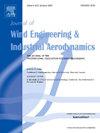Numerical study of relationship between the meandering flow beneath the underbody of trains and fluctuating aerodynamic force of a tail car
IF 4.9
2区 工程技术
Q1 ENGINEERING, CIVIL
Journal of Wind Engineering and Industrial Aerodynamics
Pub Date : 2025-07-15
DOI:10.1016/j.jweia.2025.106173
引用次数: 0
Abstract
In this study, a large-eddy simulation (LES) was conducted to investigate the relationship between the meandering flow generated beneath the underbody of a 6-car train model and the unsteady lateral aerodynamic forces (fluctuating aerodynamic force) acting on the tail car. Previous studies observed meandering flow beneath the underbody through experiments, numerical simulations, and full-scale tests, and also clarified the mechanism underlying flow-induced vibration in the tunnel section. However, the relationship between the fluctuating aerodynamic force that may causes the vibration of the tail car in open air conditions and the meandering flow has not been thoroughly examined. Our numerical study found that the fluctuating aerodynamic force on the tail car was amplified when meandering flow developed. The phase-averaging method revealed that the fluctuating aerodynamic force on the tail car and meandering flow are synchronized phenomena. Mode-decomposition methods identified a three-dimensional antisymmetric mode, with a frequency close to that of the meandering flow, which generated a significant fluctuating aerodynamic force near the tail region. Based on the findings of this study, a re-evaluation of the full-scale tests of high-speed trains revealed that the concept of meandering flow offers a more comprehensive understanding of the flow behavior around tail cars.
车体下曲流与尾车波动气动力关系的数值研究
本文采用大涡模拟(LES)方法,研究了6节车厢列车模型车底下产生的曲流与尾部车厢所受非定常横向气动力(波动气动力)的关系。以往的研究通过实验、数值模拟和全尺寸试验观察了底体下的曲流流动,阐明了隧道断面流动诱发振动的机理。然而,露天条件下引起尾车振动的波动气动力与曲流之间的关系尚未得到深入的研究。数值研究发现,当曲流形成时,尾车上的波动气动力会被放大。相位平均方法表明,尾车气动力波动与曲流是同步现象。模态分解方法识别出一种三维反对称模态,其频率接近曲流,在尾翼附近产生明显的波动气动力。基于本研究的结果,对高速列车全尺寸试验的重新评估表明,蜿蜒流的概念可以更全面地理解尾部车厢周围的流动行为。
本文章由计算机程序翻译,如有差异,请以英文原文为准。
求助全文
约1分钟内获得全文
求助全文
来源期刊
CiteScore
8.90
自引率
22.90%
发文量
306
审稿时长
4.4 months
期刊介绍:
The objective of the journal is to provide a means for the publication and interchange of information, on an international basis, on all those aspects of wind engineering that are included in the activities of the International Association for Wind Engineering http://www.iawe.org/. These are: social and economic impact of wind effects; wind characteristics and structure, local wind environments, wind loads and structural response, diffusion, pollutant dispersion and matter transport, wind effects on building heat loss and ventilation, wind effects on transport systems, aerodynamic aspects of wind energy generation, and codification of wind effects.
Papers on these subjects describing full-scale measurements, wind-tunnel simulation studies, computational or theoretical methods are published, as well as papers dealing with the development of techniques and apparatus for wind engineering experiments.

 求助内容:
求助内容: 应助结果提醒方式:
应助结果提醒方式:


